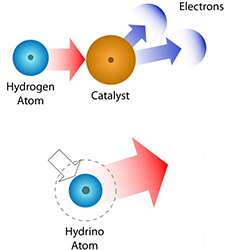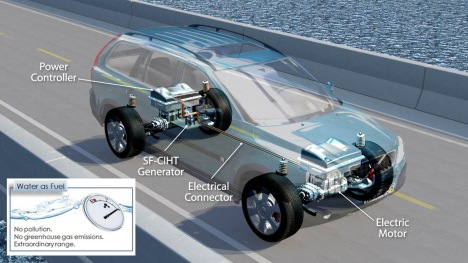Understandably this sounds impossible. But this is not just another freaky idea but a revolutionary hi-tech project.
A prototype has not yet been made, but the predicted fuel consumption is based on scientific studies of a new promising energy technology, invented by Dr Randell Mills at Blacklight Power inc.
Dr Mills discovered that the hydrogen atom has a formerly unknown state, called the Hydrino, which has a lower energy level than ordinary hydrogen.
 The transition of Hydrogen into Hydrinos generates huge amounts of energy. This phenomenon is nothing new or mystical – it is well known in physics that the transition of an atom to a lower energy level brings about a large release of energy – the news is that hydrinos exist.
The transition of Hydrogen into Hydrinos generates huge amounts of energy. This phenomenon is nothing new or mystical – it is well known in physics that the transition of an atom to a lower energy level brings about a large release of energy – the news is that hydrinos exist.
Dr Mills realized that if a method for steady generation of the Hydrino state could be created, it would be a powerful energy source – and cheap, because water could be used as the hydrogen source. After a few years of trials he discovered special catalyzing substances that enable the transition of hydrogen into hydrinos, see the image.
First, he developed methods to transform the great heat, that was generated at the transtion, into electric energy, and this worked in small scale experiments.
In the spring of 2014 he presented an ingenious, even better and cheaper method. It is based on the fact that, at the transition into the Hydrino state, enormous amounts of light energy are released – 50.000 times more intense than sunlight at ground level. To harvest this energy, ordinary photovoltaic sun cells can be used, generating large amounts of electrical energy from the light.
The amount of energy that can be obtained in this way from one liter water is so large that it can fuel a medium size car electrically for about 3000 miles.
A concept car
Let us study the car that is shown in the image below. Please note the very small size of the power generating unit (the SF-CIHT Generator) just in front of the back wheel axle, the power controller just behind the generator being considerably larger, but yet not larger than a suitcase. Modern electric motors are also small, and so is the one found at the front axle. No battery is needed and a one-litre fuel tank is enough. Altogether this system weighs considerably less and is simpler than the drive train of a internal combustion engine propelled car. The construction and material costs are also less. Although very economic, the motor can be very powerful (Published with the courtesy of Blacklight Power):
Blacklight Power writes about this project:
“Consider the automotive SunCell™ application. Based on the hydrogen content of H2O and the electricity that can be produced from the corresponding hydrogen, the maximum theoretical range from a liter of water for a standard mid-sized car is 3000 miles. A concept SunCell™ electric vehicle is shown ..[in the image above]. Based on projections of the SunCell™ power density and available materials, a 250 cubic centimeter generator could deliver 200 kW or 267 HP and weigh less than 2 kg, less than 1% the weight of an internal combustion engine (ICE) of the same power. The total projected cost of the SunCell™ generator, control electronics, electric motors, and transmission, is less than the cost of the of the ICE and drive train of a conventional gasoline-fired vehicle without any fuel costs or pollution; nor, does the SunCell™-powered car require an expensive, range limiting battery or electric charging as is the case of electric vehicles such as the Chevrolet Volt, Nissan Leaf, or Tesla. The corresponding SunCell™ economics forecast a shift from the fossil fuel business to vehicle leasing or a mileage credit card system as a means to derive even greater profits from payment for miles traveled without the need to extract, refine, transport, or sell gasoline, for example. Source: Business summary of BlackLight Power
Conclusion
It still remains to prove that this system works in practice for propelling cars, but the system is basically so simple that it is essentially, as far as I have understood, a question of finding the optimal technical solutions, which hopefully is feasible.
If it works in cars it would, when implemented at a large scale, drastically reduce the unhealthy air pollution from cars, trucks and buses. This would contribute importantly to improved health, because transportation exhausts are the most important source of harmful air pollution, see Union of Concerned Scientits.
Air pollution would furthermore be brought to a very low level if this method of energy generation is generally applied, because all kinds of energy sources can be fuelled by this system, including heating of water and houses, industrial processes as well as large scale electricity generation etc. Greenhouse gases would decrease, (but recently it has been questioned if it is these gases that are the major cause global warming).
Economies would improve greatly because of the very cheap costs of this energy source. As said in the posting “Hydrino power – superior to nuclear energy?“, it would truly be NobelPrice-worthy if it can be implemented as envisioned by Dr Randell Mills.
Filed under: Uncategorized | Tagged: alternative energy, hydrino, hydrogen energy, miscellaneous, News, solar power, technology, water energy, water fuel, water fuelled car |



Leave a comment